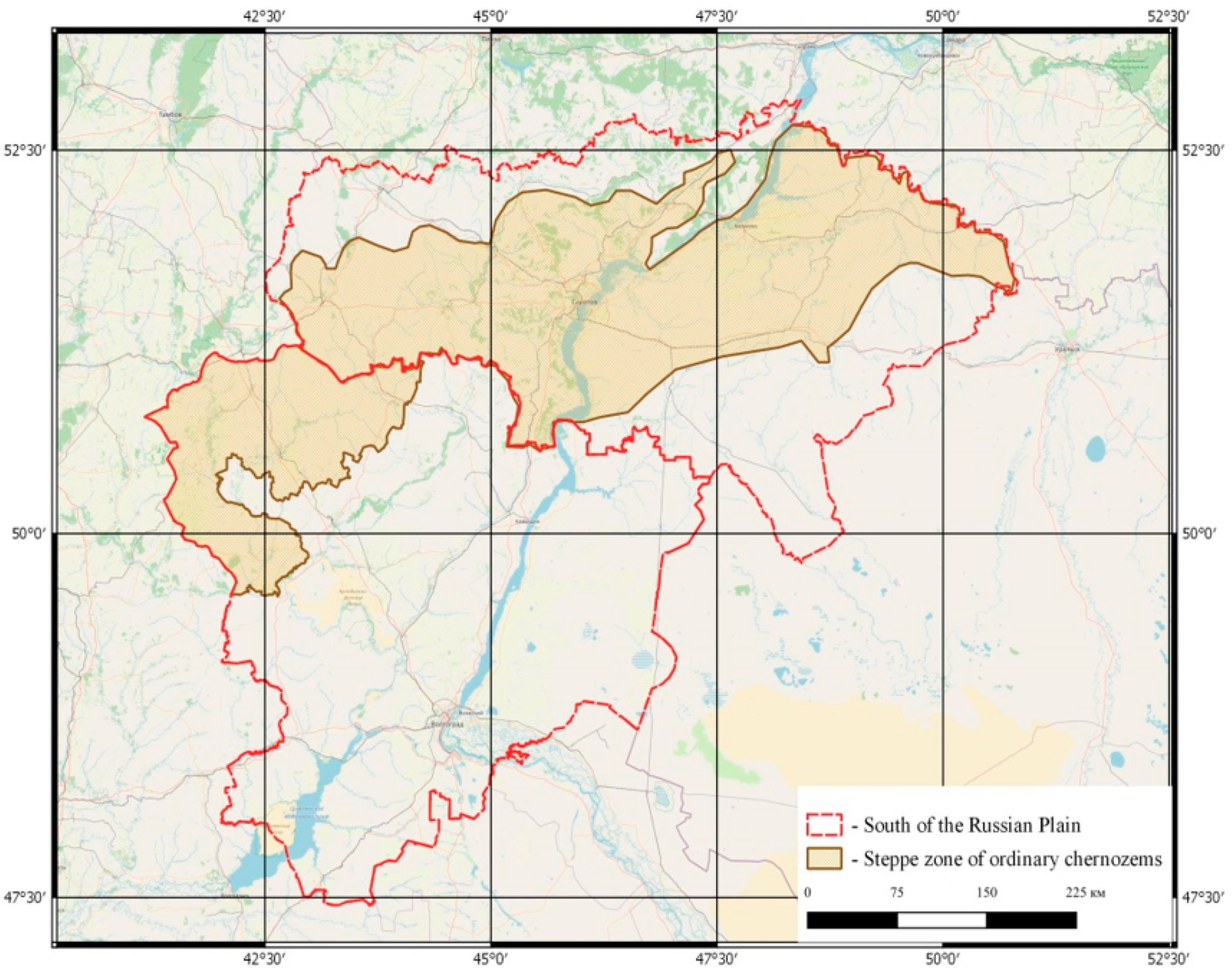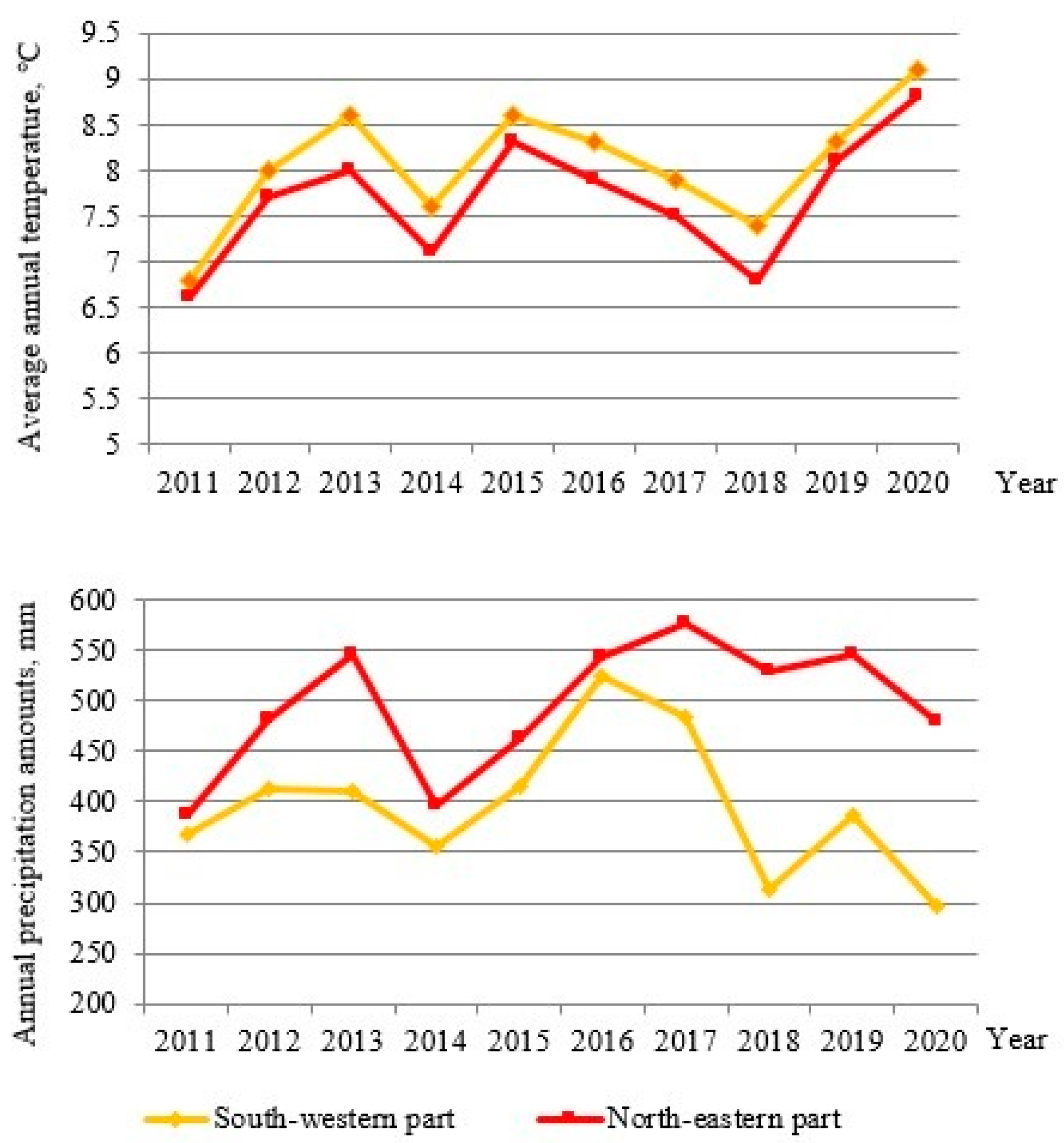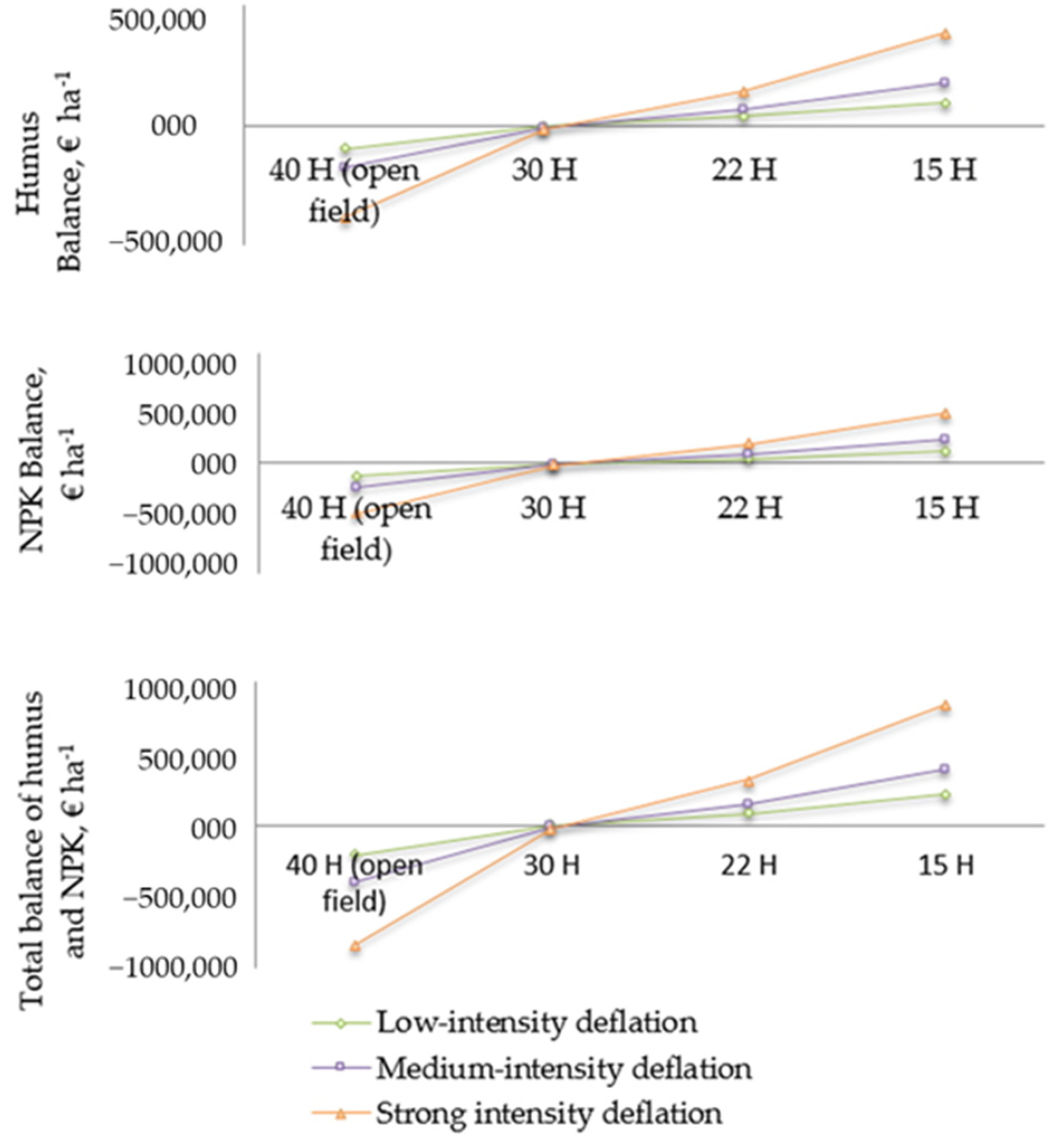Economic Evaluation of Ecological Restoration of Degraded Lands through Protective Afforestation in the South of the Russian Plain
Abstract
:1. Introduction
2. Materials and Methods
2.1. Case Study Sites
Modeling of Systems of Protective Forest Stands and Crop Rotations
2.2. Data Collection
2.3. Data Analyses
2.3.1. Assessment of Ecological and Economic Damage from Loss of Soil Fertility as a Result of the Formation of Wind Erosion on the Site
2.3.2. Assessment of the Impact of Forests on Reducing Degradation and Increasing the Sustainability of Land Use
2.4. Caveats of Study
3. Results
3.1. Assessment of Ecological and Economic Damage from Loss of Soil Fertility as a Result of the Formation of Wind Erosion on the Site
3.2. Assessment of the Impact of Forests on Reducing Degradation and Increasing the Sustainability of Land Use
4. Discussion
4.1. Assessment of Ecological and Economic Damage from Loss of Soil Fertility as a Result of the Formation of Wind Erosion on the Site
4.2. Assessment of the Impact of Forests on Reducing Degradation and Increasing the Sustainability of Land Use
5. Conclusions
Funding
Institutional Review Board Statement
Informed Consent Statement
Data Availability Statement
Conflicts of Interest
References
- Dolgilevich, M.I.; Vasiliev, Y.I.; Sazhin, A.N. Windbreak Systems and Wind Erosion; Lesnaya promyshlennost’: Moscow, Russia, 1981. [Google Scholar]
- Brandle, J.; Hodges, L.; Wight, B. Windbreak practices. In North American Agroforestry: An Integrated Science and Practice; Garrett, H.E., Rietveld, W.J., Fisher, R.F., Eds.; American Society of Agronomy: Madison, WI, USA, 2000; pp. 79–118. [Google Scholar]
- FAO (Food and Agriculture Organisation of the United Nations). FAO’s Work on Agroecology; United Nations: Rome, Italy, 2018; Available online: http://www.fao.org/3/i9021en/I9021EN.pdf (accessed on 15 May 2021).
- Current, D.; Lutz, E.; Scherr, S. Costs, Benefits and Farmer Adoption of Agroforestry: Project Experience in Central America and the Caribbean; World Bank: Washington, DC, USA, 1995; Available online: https://link.springer.com/article/10.1007/BF00708915 (accessed on 1 May 2021).
- Hillbrand, A.; Borelli, S.; Conigliaro, M.; Olivier, A. Agroforestry for Landscape Restoration: Exploring the Potential of Agroforestry to Enhance the Sustainability and Resilience of Degraded Landscapes; Food and Agriculture Organization of the United Nations: Rome, Italy, 2017; Available online: http://www.fao.org/3/b-i7374e.pdf (accessed on 1 May 2021).
- Wilson, M.H.; Lovell, S.T. Agroforestry—The next step in sustainable and resilient agriculture. Sustainability 2016, 8, 574. [Google Scholar] [CrossRef] [Green Version]
- Brandle, J.R.; Hodges, L.; Zhou, X.H. Windbreaks in North American agricultural systems. Agrofor. Syst. 2004, 61, 65–78. [Google Scholar]
- Lal, R. Soil erosion impact on agronomic productivity and environment quality. Crit. Rev. Plant Sci. 1998, 17, 319–464. [Google Scholar] [CrossRef]
- Kibblewhite, M.G.; Miko, L.; Montanarella, L. Legal frameworks for soil protection: Current development and technical information requirements. Curr. Opin. Environ. Sustain. 2012, 4, 573–577. [Google Scholar] [CrossRef]
- Nkonya, E.; Mirzabaev, A.; von Braun, J. Economics of land degradation and improvement: An introduction and overview. In Economics of Land Degradation and Improvement—A Global Assessment for Sustainable Development; Nkonya, E., von Braun, J., Mirzabaev, A., Eds.; Springer: Basel, Switzerland, 2016; pp. 1–14. [Google Scholar]
- Nair, P.K.R. An Introduction to Agroforestry; Kluwer Academic Publishers: Dordrecht, The Netherlands, 1993. [Google Scholar]
- Sileshi, G.W.; Mafongoya, P.L.; Akinnifesi, F.K.; Phiri, E.; Chirwa, P.; Beedy, T.; Makumba, W.; Nyamadzawo, G.; Njoloma, J.; Wuta, M.; et al. Fertilizer Trees. Encyclopedia of Agriculture and Food Systems; Elsevier: San Diego, CA, USA, 2014; Volume 1. [Google Scholar]
- Oenema, O.; Kros, H.; de Vries, W. Approaches and uncertainties in nutrient budgets: Implications for nutrient management and environmental policies. Eur. J. Agron. 2003, 20, 3–16. [Google Scholar] [CrossRef]
- Sileshi, G.W.; Mafongoya, P.L.; Nath, A.J. Agroforestry systems for improving nutrient recycling and soil fertility on degraded lands. In Agroforestry for Degraded Landscapes; Dagar, J.C., Gupta, S.R., Teketay, D., Eds.; Springer: Singapore, 2020; pp. 225–254. [Google Scholar]
- Tribunskaya, V.M. Economic Efficiency of Protective Forest Plantations in the System of Soil Protection from Erosion; Agropromizdat: Moscow, Russia, 1990. [Google Scholar]
- Rulev, A.S.; Pugachova, A.M. Formation of a new agroforestry paradigm. Bull. Russ. Acad. Sci. 2019, 10, 1044–1051. [Google Scholar] [CrossRef]
- Yin, R.S.; Hyde, W.F. The impact of agroforestry on agricultural productivity: The case of Northern China. Agrofor. Syst. 2000, 50, 179–194. [Google Scholar] [CrossRef]
- Buck, L.; Lassoie, J.; Fernandes, E. Agroforestry in Sustainable Agricultural Systems; CRC Press: Boca Raton, FL, USA, 1999. [Google Scholar]
- Bobylev, S.N. Sustainable development for future generations: Economic priorities. World New Econ. 2017, 3, 90–96. [Google Scholar]
- Korneeva, E.A. Efficiency of financing of forest reclamation measures for ensuring sustainable development of agricultural regions in the South of the European territory of Russia. Econ. Reg. 2020, 16, 871–883. [Google Scholar]
- Bobylev, S.N.; Solovyova, S.V. Sustainable development goals for the future of Russia. Stud. Russ. Econ. Dev. 2017, 3, 26–33. [Google Scholar] [CrossRef]
- Agrochemical Characteristics of Soils of the USSR. Volga Region; Nauka: Moscow, Russia, 1966.
- Shashko, D.I. Agro-Climatic Resources of the USSR; Hydrometeoizdat: Leningrad, Russia, 1985. [Google Scholar]
- Open Portals of Climatic Data of Russia. Available online: https://climate-energy.ru/material/ (accessed on 3 September 2021).
- Dolgilevich, M.I. Dust Storms and Agroforestry Measures; Kolos: Moscow, Russia, 1978. [Google Scholar]
- Morgan, R.P.C. Soil Erosion and Conservation, 3rd ed.; Blackwell Publishing: Oxford, UK, 2005. [Google Scholar]
- Kalyanov, K.S. Dynamics of Wind Erosion Processes of Soils; Nauka: Moscow, Russia, 1976. [Google Scholar]
- Burgess, P.J.; Graves, A.; García de Jalón, S.; Palma, J.H.N. Modelling agroforestry systems. In Agroforestry for Sustainable Agriculture; Mosquera-Losada, M.R., Prabhu, R., Eds.; Burleigh Dodds Science Publishing: Cambridge, UK, 2019; pp. 209–238. [Google Scholar]
- Ritchie, K. Shelterbelt plantings in semi-arid areas. Agric. Ecosyst. Environ. 1988, 22, 425–440. [Google Scholar] [CrossRef]
- Vasil’ev, Y.I. The Effectiveness of the Systems of Forest Belts in the Fight against Deflation of Soils; All-Russian Research Institute of Agroforestry: Volgograd, Russia, 2003. [Google Scholar]
- Koshelev, A.V.; Tubalov, A.A. Assessment of the fertility of irrigated lands of the Volgograd Volga region by modern research methods. Sci. Agron. J. 2020, 4, 35–42. [Google Scholar]
- Manaenkov, A.S. Forest Reclamation of Arid Zone Arenas, 2nd ed.; Federal Scientific Center of Agroecology, Complex Melioration and Protective Afforestation Russian Academy of Sciences: Volgograd, Russia, 2018. [Google Scholar]
- Kuznetsova, I.V.; Azovtseva, N.A.; Bondarev, A.G. Standards for changes in the physical properties of soils in the steppe, dry-steppe, semi-desert zones of the European territory of Russia. Byulleten Pochvennogo Inst. Im. V.V. Dokuchaeva 2011, 67, 3–19. [Google Scholar]
- Pugacheva, A.M. The influence of homogeneous stands on the recovery of secondary virgin landsin agroforestry landscapes of dry steppes. Biol. Bull. 2021, 2, 184–192. [Google Scholar]
- Jose, S. Agroforestry for ecosystem services and environmental benefits: An overview. Agrofor. Syst. 2009, 76, 1–10. [Google Scholar] [CrossRef]
- Porter, J.; Costanza, R.; Sandhu, H.; Sigsgaard, L.; Wratten, S. The Value of Producing Food, Energy, and Ecosystem Services within an Agro-Ecosystem. AMBIO 2009, 38, 186–193. [Google Scholar] [CrossRef]
- Liu, S.; Costanza, R.; Farber, S.; Troy, A. Valuing ecosystem services. Theory, practice, and the need for a transdisciplinary synthesis. Ecol. Econ. Rev. 2010, 1185, 54–78. [Google Scholar]
- Manaenkov, A.S. Development of the basics of steppe and protective afforestation: Theoretical, applied aspects and tasks in modern conditions. Bull. PSTU 2016, 2, 5–23. [Google Scholar]
- Korneeva, E.A. Forest reclamation as a factor of sustainable development of agricultural production in the Volgograd region. AIC Econ. Manag. 2019, 6, 55–63. [Google Scholar] [CrossRef]
- Korneeva, E.A. Expenses for forest reclamation of degraded lands of the Volgograd region. Agrar. Bull. Ural. 2018, 10, 4–9. [Google Scholar] [CrossRef]
- Wilson, S.J.; Cook, R.U. Wind erosion. In Soil Erosion; Kirkby, M.J., Morgan, R.P.C., Eds.; John Wiley & Sons: Chichester, UK, 1980; pp. 217–251. [Google Scholar]
- Tatarko, J.; Trujill, W.; Schipansk, M. Wind Erosion Processes and Control; Colorado State University Extencion: Fort Collins, CO, USA, 2019. [Google Scholar]
- Lyles, L. Possible effects of wind erosion on soil productivity. J. Soil Water Conserv. 1975, 30, 279–283. [Google Scholar]
- Borrelli, P.; Lugato, E.; Montanarella, L.; Panagos, P. A new assessment of soil loss due to wind erosion in european agricultural soils using a quantitative spatially distributed modelling approach. Land Degrad. Develop. 2016, 28, 335–344. [Google Scholar] [CrossRef] [Green Version]
- Riksen, M.J.P.M.; De Graaff, J. On-site and off-site effects of wind erosion on European light soils. Land Degrad. Dev. 2001, 12, 1–11. [Google Scholar] [CrossRef]
- Shi, P.; Yan, P.; Yuan, Y.; Nearing, M.A. Wind erosion research in China: Past, present and future. Prog. Phys. Geogr. 2004, 28, 366–386. [Google Scholar] [CrossRef]
- Report on the State and Use of Agricultural Lands of the Russian Federation in 2018; FGBNU Rosinformagrotech: Moscow, Russia, 2020.
- European Commission. European Commission—Thematic Strategy for Soil Protection. 2006. Available online: http://ec.europa.eu/environment/soil/three_en.htm (accessed on 5 September 2021).
- Kuhlman, T.; Reinhard, S.; Gaaf, A. Estimating the costs and benefits of soil conservation in Europe. Land Use Policy 2010, 27, 22–32. [Google Scholar] [CrossRef]
- Robinson, D.A.; Fraser, I.; Dominati, E.J.; Davísdóttir, B.; Jónsson, J.O.G.; Jones, L.; Jones, S.B.; Tuller, M.; Lebron, I.; Bristow, K.L.; et al. On the value of soil resources in the context of natural capital and ecosystem service delivery. Soil Sci. Soc. Am. J. 2014, 78, 685–700. [Google Scholar] [CrossRef] [Green Version]
- Dixon, J.A.; Scura, L.F.; Carpenter, R.A.; Sherman, P.B. Economic Analysis of the Environmental Impacts, 2nd ed.; Earthscan Publication Ltd.: London, UK, 1994. [Google Scholar]
- Enters, T. Methods for the Economic Assessment of the On-and Off-Site Impacts of Soil Erosion; International Board for Soil Research and Management (IBSRAM): Bangkok, Thailand, 1998. [Google Scholar]
- García de Jalón, S.; Graves, A.; Palma, J.H.N.; Williams, A.; Upson, M.; Burgess, P.J. Modelling and valuing the environmental impacts of arable, forestry and agroforestry systems: A case study. Agrofor. Syst. 2017, 92, 1059–1073. [Google Scholar] [CrossRef] [Green Version]
- Brandle, J.R.; Finch, S. How windbreaks work. Pap. Nat. Resour. 1991, 121, 1–5. [Google Scholar]
- Heisler, G.; DeWalle, D. Effects of windbreak structure on wind flow. Agric. Ecosyst. Environ. 1988, 22, 41–69. [Google Scholar] [CrossRef]
- Bhardwaj, D.R.; Navale, M.R.; Sharma, S. Agroforestry practices in temperate regions of the world. In Agroforestry; Dagar, J.C., Tewary, V.P., Eds.; Springer Nature: Singapore, 2017; pp. 163–187. [Google Scholar]
- Lehmann, L.; Smith, J.; Westaway, S.; Pisanelli, A. Productivity and economic evaluation of agroforestry systems for sustainable production of food and non-food products. Sustainability 2020, 12, 5429. [Google Scholar] [CrossRef]
- Kretinin, V.M. The soil-improving role of protective forest stands in the semiarid and arid regions of the North Caucasus and the south-east of the ETR. In Theory and Practice of Forest Reclamation and Forest-Agrarian Development of Arid Territories; Kulik, K.N., Ed.; All-Russian Research Institute of Agroforestry: Volgograd, Russia, 2001. [Google Scholar]
- Stocking, M.; Bojo, J.; Abel, N. Financial and economic analysis of agroforestry: Key issues. In Agroforestry for Sustainable Production: Economic Implications; Prinsley, R.T., Ed.; The Commonwealth Secretariat: London, UK, 1990; pp. 13–119. [Google Scholar]



| Calculated Indicators | Humus | Nitrogen (N) | Phosphorus (P) | Potassium (K) | Total Quantity |
|---|---|---|---|---|---|
| Brand of mineral fertilizers that replace nutrients in the soil | Litter manure of cattle | Ammonium nitrate | Double granulated superphosphate | Potassium chloride | Nitrogen-containing and active substance NPK |
| Organic fertilizer | NH4NO3 | Ca (H2PO4) 2·H2O | CHl | ||
| Losses of organic and mineral substances in the soil profile (A + B), ton ha−1: | |||||
| Low-intensity deflation | 24.2 | 0.96 | 0.38 | 1.93 | 27.47 |
| Medium-intensity deflation | 44 | 1.8 | 0.72 | 3.6 | 50.12 |
| High-intensity deflation (dust storms) | 94.6 | 3.84 | 1.54 | 7.7 | 107.68 |
| The amount of fertilizers equivalent to humus and the active substance NPK, ton ha−1: | |||||
| Low-intensity deflation | 121 | 2.82 | 0.82 | 3.08 | 127.72 |
| Medium-intensity deflation | 220 | 5.29 | 1.56 | 5.75 | 232.6 |
| High-intensity deflation (dust storms) | 473 | 11.29 | 3.34 | 12.32 | 499.95 |
| Compensatory costs for the replacement of fertility losses, ha−1: | |||||
| Low-intensity deflation | EUR 1957 | EUR 959 | EUR 242 | EUR 1175 | EUR 4333 |
| Medium-intensity deflation | EUR 3560 | EUR 1799 | EUR 461 | EUR 2194 | EUR 8014 |
| High-intensity deflation (dust storms) | EUR 7653 | EUR 3838 | EUR 986 | EUR 4699 | EUR 17176 |
| Calculated Indicators | Forest Reclamation Strategy 1 | Forest Reclamation Strategy 2 | Forest Reclamation Strategy 3 | |||
|---|---|---|---|---|---|---|
| The range of influence of trees, H | 30 | 22 | 15 | |||
| Wind speed reduction, % of the speed in the open field [28] | 10 | 20 | 35 | |||
| The main forest-forming breed | 1 | 2 | 1 | 2 | 1 | 2 |
| Forest stand–forest stand space, meters | 500 | 350 | 240 | |||
| Coefficient of protection of land use (wind erosion control) | 0.48 | 0.69 | ~1.00 | |||
| Width of forest stands, meters | 12 | 9 | 12 | 9 | 12 | 9 |
| Total number of forest stands, pieces | 6 | 7 | 10 | |||
| Total area of forest stands, ha | 14.4 | 10.8 | 16.8 | 12.6 | 24.0 | 18.0 |
| Protective forest cover, % | 3.6 | 2.7 | 4.2 | 3.2 | 6.0 | 4.5 |
| Costs for the arrangement of land with forest plantations per 1 ha of agroforest landscape | EUR 26 | EUR 32 | EUR 34 | EUR 43 | EUR 41 | EUR 52 |
| Calculated Indicators | Forest Reclamation Strategy 1 | Forest Reclamation Strategy 2 | Forest Reclamation Strategy 3 | |||
|---|---|---|---|---|---|---|
| The main forest-forming breed | 1 | 2 | 1 | 2 | 1 | 2 |
| Protective forest cover, % | 3.6 | 2.7 | 4.2 | 3.2 | 6 | 4.5 |
| Protection of forest land use, % | 48 | 48 | 69 | 69 | ~100 | ~100 |
| Average annual effect due to losses/prevented losses of soil fertility, ha−1: | ||||||
| Low-intensity deflation | EUR −50 | EUR −50 | EUR 376 | EUR 400 | EUR 1002 | EUR 1066 |
| Medium-intensity deflation | EUR −157 | EUR −157 | EUR 696 | EUR 741 | EUR 1852 | EUR 1970 |
| High-intensity deflation (dust storms) | EUR −338 | EUR −338 | EUR 1487 | EUR 1582 | EUR 3968 | EUR 4222 |
| Effect for the operational life of the main forest-forming breed, ha−1: | ||||||
| Low-intensity deflation | EUR −2476 | EUR −1733 | EUR 18779 | EUR 13984 | EUR 50111 | EUR 37316 |
| Medium-intensity deflation | EUR −7859 | EUR −5501 | EUR 34815 | EUR 25926 | EUR 92596 | EUR 68955 |
| High-intensity deflation (dust storms) | EUR −16887 | EUR −11821 | EUR 74350 | EUR 55355 | EUR 198417 | EUR 147758 |
| Sustainability of land use | − | − | + | + | + | + |
Publisher’s Note: MDPI stays neutral with regard to jurisdictional claims in published maps and institutional affiliations. |
© 2021 by the author. Licensee MDPI, Basel, Switzerland. This article is an open access article distributed under the terms and conditions of the Creative Commons Attribution (CC BY) license (https://creativecommons.org/licenses/by/4.0/).
Share and Cite
Korneeva, E.A. Economic Evaluation of Ecological Restoration of Degraded Lands through Protective Afforestation in the South of the Russian Plain. Forests 2021, 12, 1317. https://doi.org/10.3390/f12101317
Korneeva EA. Economic Evaluation of Ecological Restoration of Degraded Lands through Protective Afforestation in the South of the Russian Plain. Forests. 2021; 12(10):1317. https://doi.org/10.3390/f12101317
Chicago/Turabian StyleKorneeva, Evgenia A. 2021. "Economic Evaluation of Ecological Restoration of Degraded Lands through Protective Afforestation in the South of the Russian Plain" Forests 12, no. 10: 1317. https://doi.org/10.3390/f12101317





